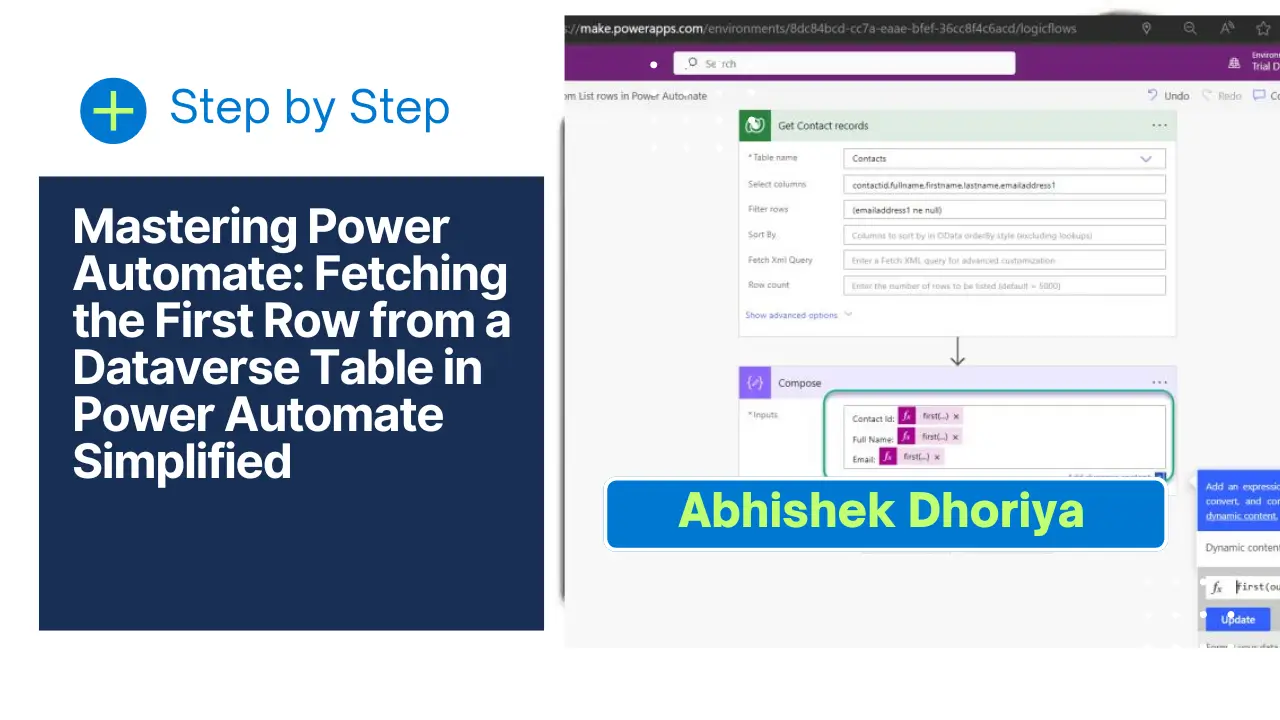Unlocking the Power of Dataverse: Fetching the First Row from a Dataverse Table in Power Automate Simplified
Are you new to Microsoft Power Automate and Dataverse? If you’re scratching your head trying to figure out how to pull the first row from a Dataverse table, you’re in the right place. This comprehensive guide will walk you through each step in a manner that’s easy to grasp, even for beginners. By the end of this article, you’ll be fetching Dataverse records like a pro.
Power Automate, part of the Microsoft Power Platform, allows users to automate repetitive tasks. One such task is extracting the first row of a table in Dataverse. But don’t worry; this isn’t rocket science. Read on to understand how to accomplish this with ease.
Introduction to Dataverse and Power Automate
First things first: What is Dataverse, and how does Power Automate fit into the picture?
Microsoft Dataverse is a cloud-based data storage platform that allows you to securely store and manage data used by business applications. It bridges the gap between various applications by allowing data to flow seamlessly.

Microsoft Dataverse is a scalable data service and app platform that simplifies data management and integration. You can use it to store and manage data used by business applications. Now, coupling Dataverse’s robust data management capabilities with Power Automate’s automation features provides a powerful combination for business solutions.
Power Automate, on the other hand, is a service that helps you create automated workflows between apps and services to synchronize files, get notifications, collect data, and more. When combined, these tools become incredibly powerful, especially when you need to get specific data like the first row of a table.

Why is Fetching the First Row Important?
There are multiple scenarios where fetching the first row of a table might be necessary:
- Initialization: Initializing a process with the first record.
- Previewing Data: To preview the first entry for quick reference.
- Conditional Logic: To build conditional logic based on the first record’s data.
Step-by-Step Guide: Fetching the First Row in Power Automate
1. Creating A Flow
First, let’s create an automated flow in Power Automate:
- Navigate to Power Automate.
- Select Create, then choose your flow type (Automated, Instant, or Scheduled).

2. Adding the Dataverse Connector
Once you’ve created your flow:
- Add a new step.
- Search for “Dataverse” and select the Dataverse Connector.
- Choose the List Rows action.
3. Configuring the ‘List Rows’ Action
Next, configure the ‘List Rows’ action:
- Select your environment.
- Select the table you want to fetch data from.
- In the OData Filter Query, you can specify filters if necessary, but leave it blank for now as we want to fetch all rows initially.
4. Applying the Top Count
To ensure we only fetch the first row:
- Scroll down to the Advanced Options.
- Set the Top Count to 1.
This setting limits the result to the first row.
5. Processing the First Row Data
Next, we’ll extract and use the data from the first row:
- Add a new step after the List Rows action.
- Choose the Compose action.
- In the Inputs, use the expression
first(body('List_Rows')?['value']).
This expression ensures you extract the first item from the array of data.
first(body('List_Rows')?['value'])- If you need specific columns, use the syntax:
first(body('List_Rows')?['value']).[ColumnName].
Conclusion
Congratulations! You’ve now learned how to fetch the first row from a Dataverse table using Microsoft Power Automate. This knowledge can be a game-changer, simplifying your workflows and making data management seamless. As always, practice makes perfect, so keep experimenting with other Power Automate features to build more complex and efficient flows.
Frequently Asked Questions (FAQs)
How do I get the first row of a Dataverse table in Power Automate?
You can get the first row of a Dataverse table by using the List Rows action in Power Automate, then setting the Top Count to 1.
How do I get the first record of a list in Power Automate?
Use the first() function with the body of the List Rows output: first(body('List_Rows')?['value']).
What expression is used to get the first row in Power Automate Dataverse?
The expression first(body('List_Rows')?['value']) is used to get the first row from the Dataverse Table.
Can Power Automate fetch the first row of data from Dataverse?
Yes, Power Automate can fetch the first row by configuring the List Rows action and setting the Top Count to 1.
How to get specific columns from the first row in Dataverse with Power Automate?
After setting up the List Rows action, use an expression like first(body('List_Rows')?['value']).[ColumnName] in a Compose action.
By following these steps, you can seamlessly integrate data from Dataverse and streamline your Power Automate workflows. Happy Automating!
#MSFTAdvocate #AbhishekDhoriya #LearnWithAbhishekDhoriya #DynamixAcademy
References & Read More:
- Understanding Microsoft Power Platform ROI for Beginners
- Fetching the First Row from a Dataverse Table in Power Automate Simplified
- Demystifying GitHub Copilot in Visual Studio
- How to Overcome SharePoint List View Threshold Errors?
- Unveiling EY Dynamics 365 Sales: A Comprehensive Guide for Beginners
- Demystifying SharePoint Document Location URL Invalid Characters

5 thoughts on “Mastering Power Automate: Fetching the First Row from a Dataverse Table in Power Automate Simplified”